HTC LIBR100 Smart Phone with Bluetooth User Manual Book Libra Generic English Manual indb
HTC Corporation Smart Phone with Bluetooth Book Libra Generic English Manual indb
HTC >
Contents
- 1. User Manual 1 of 2
- 2. User Manual 2 of 2
User Manual 2 of 2
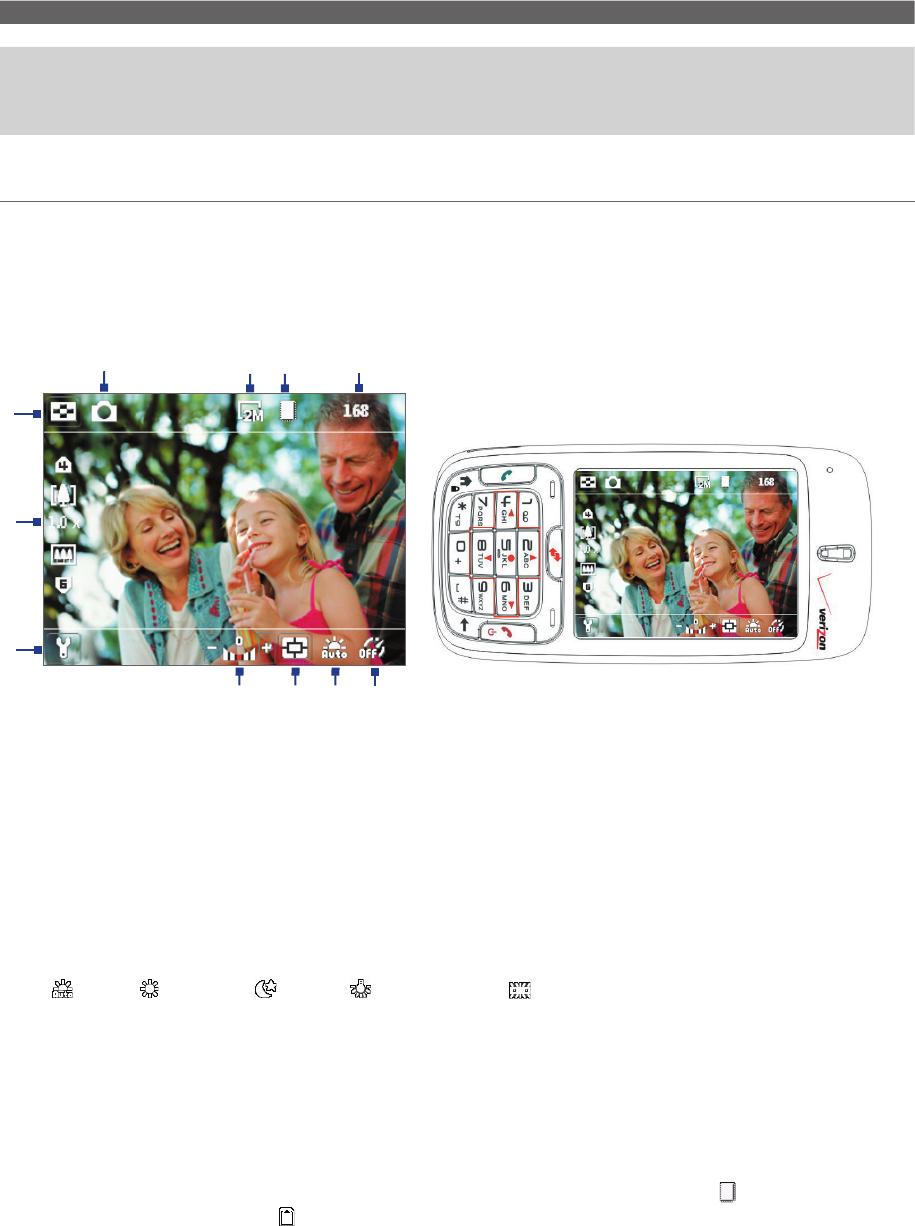
Experiencing Multimedia 81
Using the above capture modes, the camera captures files in the following formats:
Capture type Format
Still Image JPEG
Video Motion-JPEG (.avi)
MPEG-4 (.mp4)
H.263 baseline (.3gp)
3GPP2 (.3g2)
MMS Video MPEG-4 (.mp4)
H.263 baseline (.3gp)
3GPP2 (.3g2)
Camera mode icons and indicators
The Camera [Photo] screen
2
1
3
7
9
4 5 6
10 8
1 Picture Viewer. Click the left SOFT KEY to view the picture or video in Pictures & Videos.
2 Zoom-ratio. Indicates the current zoom ratio. Press NAVIGATION up/down or press the number keys as
indicated to increase or decrease the zoom level.
3 Camera Settings. Click the right SOFT KEY to open the Camera Settings screen.
4 Exposure Value (EV). Allows you to set brightness by adjusting the exposure value from -2 EV to +2 EV
(increments of 0.5) by pressing NAVIGATION left/right or using the number keys as indicated.
5 Metering Mode. Indicates the current metering mode.
6 White Balance. Indicates the current white balance setting.
: Auto; : Daylight; : Night; : Incandescent; : Fluorescent.
7 Self-timer. Indicates the current self-timer setting while capturing images. Choose the self-timer setting
(Off, 2 seconds, or 10 seconds) from the Camera Settings screen.
8 Remaining Information Indicator. In Photo, Contacts Picture, Picture Theme, Panorama, and Sports,
this shows the remaining, available shots of pictures that you can take based on the current settings. In
Video and MMS Video modes, this shows the remaining duration that can be recorded. While recording
video, this shows the recorded duration.
9 Storage. Indicates where the captured images and video clips will be saved. The icon indicates the
phone’s main memory; the icon indicates the storage card.
10 Resolution. Indicates the current image or video size based on the resolution you chose. For the list of
available resolutions, see “Use zooming.”
11 Capture mode. Indicates the current capture mode.
11
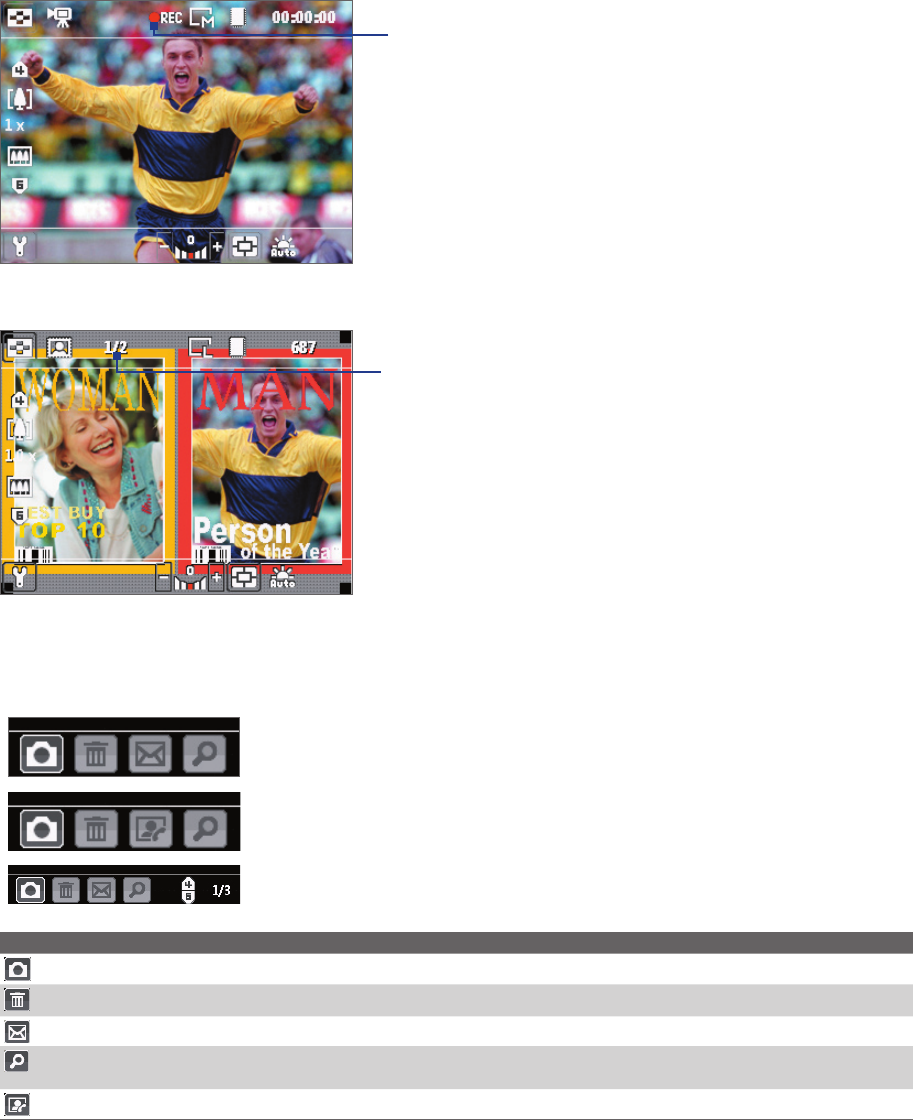
82 Experiencing Multimedia
The Camera [Video] screen
The recording status is displayed
by a red, blinking indicator while
video recording is in progress.
Recording Status
The Camera [Picture Theme] screen
Progress Indicator
In Picture Theme, Panorama, and
Sports modes, this indicates the
total number of consecutive shots.
The Review screen
After capturing image or recording video, the Review screen appears allowing you to decide the action for the
image/video.
Photo, Video, MMS Video, Picture Theme, and Panorama modes
Contacts Picture mode
Sports mode
Icon Function
Back. Click to go back to Camera screen.
Delete. Click to remove the captured image or video clip.
Send. Click to send the captured image or video clip to someone via e-mail or MMS.
View. Click to switch to Pictures & Videos to show the still image, or switch to Windows Media Player to play
back the video clip.
Assign to Contacts. Click to associate the photo to a selected contact.
Note After you have taken photos in Sports mode, the total number of consecutive shots is shown at the lower right
corner of the Review screen. Press NAVIGATION CONTROL up/down or use number keys as indicated to browse
through the sequence of photos.
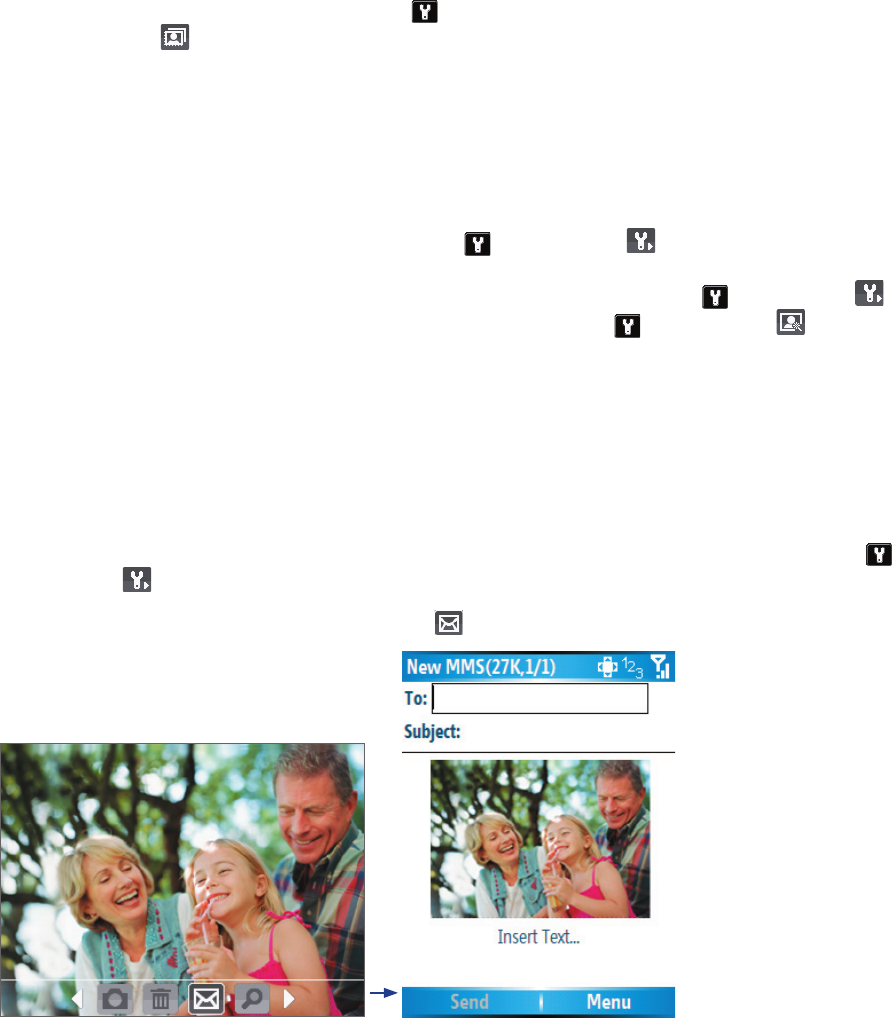
Experiencing Multimedia 83
Use Still Image capture modes
While using Still Image capture modes, such as Photo, Contacts Picture, Picture Theme, and Panorama, you
can capture a single still image by pressing ENTER. In Sports mode, press ENTER once, and then pan your
phone to take the consecutive shots. The number of shots taken depends on the option you set. Still images
are captured and saved in the JPEG format.
While capturing an image in the Picture Theme mode, you can select a preset template. To browse and choose
from different templates, click the right SOFT KEY on the Camera screen, and then use the NAVIGATION
CONTROL to select . Depending on the chosen template, one or more photos may need to be taken for the
template.
Use Video capture mode
While using the Video capture mode, press ENTER to start recording a video clip (with audio if desired). To stop
recording, press ENTER again. Your phone displays the first frame of the captured video clip by default on the
Review screen.
Before you capture a video clip, click the right SOFT KEY and then select > Capture Format to specify
the file format. You can set the encoding format to Motion-JPEG, MPEG4, H.263, or 3GPP2. You can also
specify the recording limit in terms of time or file size by pressing the right SOFT KEY then selecting >
Recording Limit. To change the video resolution, click the right SOFT KEY and then select .
Use MMS Video capture mode
While using the MMS Video capture mode, press ENTER to start recording a video clip (with audio if desired).
To stop recording, press ENTER again.
The recording length of MMS video is fixed. The recording automatically stops when the preset length is
reached. However, you can manually stop recording the video anytime. The time indicator at the top-right
side of the screen indicates the time limit.
You can specify the encoding format to be either H.263, MPEG4, or 3GPP2 by clicking the right SOFT KEY
then selecting > Capture Format; however, the ideal format for MMS is H.263 (.3gp).
After you capture the video file, click the Send icon ( ) to send the file through MMS.
Use zooming
Before capturing a still image or a video clip, you can first zoom in to make the object in focus move closer,
and you can zoom out to make the object move farther away. In all capture modes, press NAVIGATION up on
your phone to zoom in, NAVIGATION down to zoom out. You can also use the number keys as indicated to
zoom in or out in any capture mode.
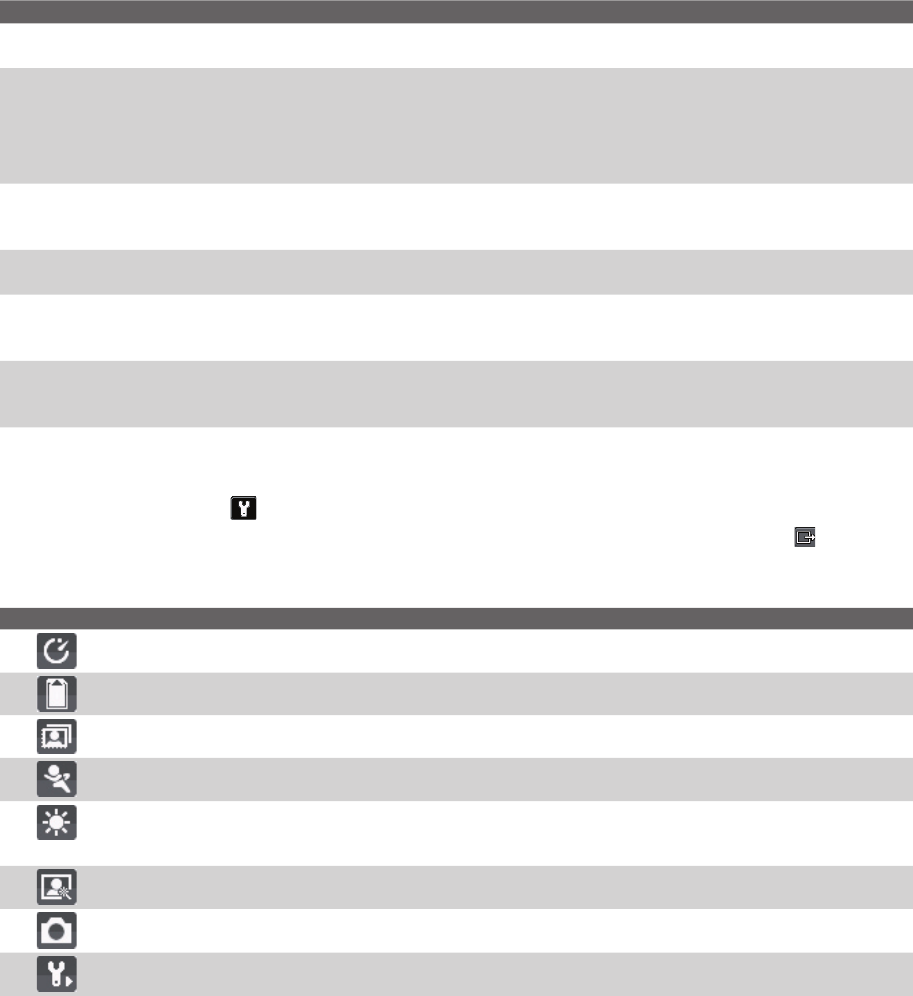
84 Experiencing Multimedia
The camera zoom range for a picture or video depends on the capture mode and capture size. The following
table is a summary. Please note the capture sizes available for certain capture formats also vary from one
capture mode to another. The zoom range has been calculated based on the following ratio:
Capture mode Resolution Zoom range
Video and MMS Video Small (128 x 96) (4:3)
Medium (176 x 144) (11:9) (default)
1.0x to 2.0x
1.0x to 2.0x
Photo Small (160 x 120) 1.0x to 10.0x
Medium (320 x 240) 1.0x to 4.0x
Large (640 x 480) 1.0x to 2.0x
1M (1280 x 960) 1.0x to 2.0x
2M (1600 x 1200) (default) No zooming
Contacts Picture Small (120 x 160)
Medium (240 x 320)
Large (480 x 640) (default)
1.0x to 4.0x
1.0x to 4.0x
1.0x to 2.0x
Picture Theme Determined by the current template Depends on the size of the currently loaded
template
Panorama Small (160 x 120)
Medium (320 x 240)
Large (640 x 480) (default)
1.0x to 10.0x
1.0x to 4.0x
1.0x to 2.0x
Sports Small (160 x 120)
Medium (320 x 240)
Large (640 x 480) (default)
1.0x to 10.0x
1.0x to 4.0x
1.0x to 2.0x
Use the Camera Menu
Clicking the right SOFT KEY on the Camera screen allows you to select various capture modes and
customize various settings for each mode. Use the NAVIGATION CONTROL or the left SOFT KEY ( ) to go
through the available settings, and click OK when you are done. The following table provides a list of general
options available in the menu.
Option Allows you to
Select the Self-timer option for capturing images: Off, 2 seconds, or 10 seconds. Selecting 2 seconds or
10 seconds delays the capturing by the specified time after you press ENTER.
Select whether to save the file in the device memory or on the memory card.
Only available in Picture Theme mode. Allows you to select a template to use for Picture Theme mode.
Only available in Sports mode. The Capture Speed option determines the interval between shots. The
Snapshots option determines how many shots to take with a single press of ENTER.
Specify
the white balance setting, such as Auto, Daylight, Night, Incandescent, and Fluorescent to suit
the lighting environment. You can also
choose a special effect, such as Grayscale, Sepia, or Cool to apply to
your photos or video clips.
Choose the resolution to use and set the metering mode to either Center Area or Average. While
capturing images, you can also set the Quality and enable Time Stamp.
Switch between different capture modes, such as Photo, Video, Contacts Picture, and more. For details, see
“Capture modes” earlier in this chapter.
Access more settings that lets you customize the Camera or Video Recorder functions. For details, see the
following section "Advanced settings of the Camera Menu."
Advanced settings of the Camera Menu
• Capture Format. Specify the file format for the image/video.
• Shutter Sound. Choose whether or not you want the camera to make a shutter sound when you press
ENTER to take photos or record video clips.
• Keep Backlight. Choose whether to turn the backlight on or off while using the camera. This overrides
your device backlight settings while you are using the camera.
• Review Duration. Set a time length for displaying the captured image/video on the Review screen
before automatically saving it and returning to the live Camera screen. Select No Limit if you do not
want to impose a time limit.

Experiencing Multimedia 85
• Show control. Select On or Off to display or hide the indicators on the Camera screen.
• Flicker Adjustment. When taking indoor shots, flicker on the camera screen may be caused by
inconsistencies between the vertical scan rate of the camera display and the flicker frequency of
fluorescent lighting. To reduce flicker, you can change the flicker adjustment setting to Auto or to the
proper frequency (50Hz or 60Hz) of the country where your device is being used.
• Record with Audio (Video and MMS Video only). Select On to record audio with the captured video
clips. This is selected by default. If you select Off and then capture a video clip, it will have no audio.
• Prefix.
Specify how to name captured images and video clips. When Default is selected, the file name
of each new captured file is set to “IMAGE” or “VIDEO” followed by a sequential number, for example:
IMAGE_001.jpg. You may also choose to name files using either the current Date or Date & Time as the
prefix
.
• Counter. By default, the newly captured image or video files are named with a prefix and some
sequential numbers such as 001, 002, and so on. To reset the numbering to 001 for your captured files,
select Reset.
• Recording Limit (Video and MMS Video only). Specify the maximum time or file size for recording.
• Template Folder (Picture Theme only). By default, templates are stored in the \My Documents\
Templates folder on the device’s Main Memory. If you transferred some templates to a storage card
(via File Explorer), set this option to Main + Card to specify that templates are located in both the main
memory and the storage card.
• Adjust. This option allows you to adjust the camera display properties, such as Contrast, Saturation,
Hue, and Sharpness. Press NAVIGATION up or down to select the property, and press NAVIGATION left
or right to change the value. You can also use the number keys as indicated to navigate and set options.
• About. Displays information about the Camera program.
7.2 Using Pictures & Videos
The Pictures & Videos program collects, organizes, and sorts images and video clips in the following formats
on your phone.
File Type File Extensions
Picture *.bmp, *.jpg
GIF image and animation *.gif
Video *.avi, *.wmv, *.mp4, *.3gp, *.3g2
You can also view the pictures as a slide show, beam them, send them via a messaging program, edit them, or
set them as the background on the Home Screen.
To copy a picture or video clip to your phone
You can copy pictures, GIF images, GIF animation files and video files from your PC and view them on your
phone.
• Copy the pictures, GIF images, GIF animation files and video files from your PC or a storage card to the
My Pictures folder on your phone. (You can also copy video files to the My Videos folder.)
For more information about copying files from your PC to your phone, see ActiveSync Help on your PC.
Note You can also copy pictures, GIF images, GIF animation files and video files from your PC to your phone using a
memory card. Insert the memory card into the memory card slot on your phone, then copy the files from your PC
to the folder you created on the memory card.
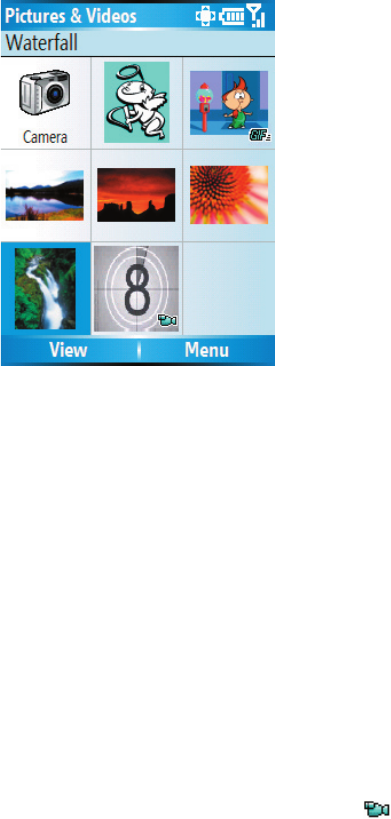
86 Experiencing Multimedia
Pictures & Videos
To view pictures
1. On the Home screen, click Start > Pictures & Videos.
The images in the My Pictures folder appear as thumbnails by default.
2. Select a picture and click View.
If you cannot find a picture in the default My Pictures folder, click Menu > Folders > My Device to go
to other folders.
To play GIF animation files
1. On the Home screen, click Start > Pictures & Videos.
2. Select the GIF animation file and click View.
To play videos
1. On the Home screen, click Start > Pictures & Videos.
Video files appear as thumbnails with a icon.
2. Select a video and click Play to play it with the built-in Windows Media Player.
To view slide shows
You can view your pictures as a slide show on your phone. Pictures are shown in full-screen view with 5-
second intervals between slides.
1. On the Home screen, click Start > Pictures & Videos.
2. Click Menu > Play Slide Show.
Note You can specify how pictures are scaled to optimize their display in a slide show. Click Menu > Options, select
Slide Show, and choose either Portrait pictures or Landscape pictures. You can even set your phone to play a
screensaver on its monitor while your phone is connected to the PC and idle for 2 minutes.
To start the camera from Pictures & Videos
• On the My Pictures folder, click Camera.
To delete a picture or video clip
• Select a picture or video clip on the Pictures & Videos screen, and click Menu > Delete. Click Yes to
confirm the deletion.
Experiencing Multimedia 87
To edit a picture
You can rotate, crop, and adjust the brightness and color contrast of your pictures.
1. On the Home screen, click Start > Pictures & Videos.
2. Select the picture you want to edit, click View.
3. Click Menu > Edit, and do any of the following:
• To rotate a picture 90 degrees, click Menu > Rotate.
• To crop a picture, click Menu > Crop. Then, drag the cursor to position it on the first corner of the
cropping area, and click Next. Select the second corner with the area to crop and click Finish, or
click Previous to go back to the previous screen and select again.
• To auto-adjust the brightness and contrast levels of a picture, click Menu > Auto Correct.
4. Click Menu > Save As to save the edited picture with a new name or at a new location.
Note To undo an edit, click Menu > Undo. To cancel all unsaved edits you made to the picture, click Menu > Cancel.
To set a picture as the Home screen background
1. On the Home screen, click Start > Pictures & Videos.
2. Select the picture you want to set as the background.
3. Click View.
4. Click Menu > Use as Home Screen.
5. Select the display area and click Next.
6. Adjust the transparency. Select a higher percentage for a more transparent picture, or a lower
percentage for a more opaque picture.
7. Click Finish.
To send pictures and video clips via e-mail
You can send pictures and video clips to other phones via e-mail.
1. First, set up Messaging to send and receive messages.
2. On the Pictures & Videos screen, select the item you want to send.
3. Click Menu > Send.
4. On the Messaging screen, select Outlook E-mail then click Select.
A new message is created with the item attached.
5. Enter the recipient name and subject, and click Send.
The message will be sent the next time you synchronize your phone.
Note Pictures and video clips are saved automatically before they are sent.
To beam pictures
You can beam a picture to your friends or family using Bluetooth technology.
1. On the Home screen, click Start > Pictures & Videos.
2. Select the picture you want to beam.
3. Click Menu > Beam.
4. Select the device to which you want to send the picture.
5. Click Beam.

88 Experiencing Multimedia
To assign pictures to contacts
You can assign a picture to a contact so that you can easily identify the contact at any time.
1. On the Home screen, click Start > Pictures & Videos.
2. Select the picture you want to assign to a contact.
3. Click Menu > Save to Contact.
4. Select the contact, and click Select.
To customize picture options
1. On the Home screen, click Start > Pictures & Videos.
2. Select the picture for which you want to configure
advanced options.
3. Click Menu > Options.
4. Select General or Slide Show on the Options screen
then press ENTER.
Selecting General on the Options screen allows you to
do the following:
• Decrease the picture size so that photos can be sent
faster via e-mail.
• Set the direction to rotate a picture.
Selecting Slide Show on the Options screen allows
you to do the following:
• Configure the view settings during slide shows.
• Activate screensaver. Pictures & Videos Menu
7.3 Using Windows Media Player
You can use Microsoft® Windows Media® Player Mobile for
Smartphone to play digital audio and video files that are
stored on your phone or on a network, such as on a Web
site.
In this documentation, the version of Windows Media
Player for Windows-based PCs is called the “desktop Player”
and the version for Smartphone is called the “device Player.”
To open Windows Media Player, click Start > Windows
Media.
These are the following file formats that are supported by
this version of Windows Media Player Mobile.
Windows Media Player

Experiencing Multimedia 89
Formats Supported File Extensions
Video
• Windows Media Video
• MPEG4 Simple Profile
• H.263
• Motion JPEG
• 3GPP2
.wmv, .asf
.mp4
.3gp
.avi
.3g2
Audio
• Windows Media Audio
• MP3
• MIDI
• AMR Narrow Band
• AMR Wide Band
• AAC
.wma
.mp3
.mid, .midi, .rmi
.amr
.awb
.m4a
About the controls
By default, these hardware buttons are assigned to Windows Media Player Mobile functions.
To Press
Play or pause ENTER
Skip to a previous file NAVIGATION left
Skip to the next file NAVIGATION right
Increase the volume NAVIGATION up
Decrease the volume NAVIGATION down
Turn the sound on or off quickly
(mute)
#
Switch to full screen during video
playback
0
Change rating *
Fast-forward a file NAVIGATION right (hold)
Rewind a file NAVIGATION left (hold)
Note You can also use the keys on the QWERTY keyboard to control the Windows Media Player Mobile functions.
About the screens and menus
Windows Media Player has three primary screens:
Playback screen. The default screen that displays the playback controls (such as Play, Pause, Next, Previous,
and Volume) and the video window. You can change the appearance of this screen by choosing a different
skin.
Now Playing screen. The screen that displays the Now Playing playlist. This special playlist indicates the
current file being played and files that are queued up to play next.
Library screen. The screen that lets you quickly find your audio files, video files, and playlists. It contains
categories such as My Music, My Videos, My TV, and My Playlists.
At the bottom of each screen is a Menu. The commands on this menu vary, depending upon which screen
you are viewing.

90 Experiencing Multimedia
Playback screen menu
When you are viewing the Playback screen, these options appear on the Menu.
Option Allows you to
Library Display the Library screen so you can choose a file to play.
Play/Pause Start or pause playback.
Stop Stop playback.
Shuffle/Repeat > Shuffle Play the items in the Now Playing playlist in random order.
Shuffle/Repeat > Repeat Play the items in the Now Playing playlist repeatedly.
Full Screen When a video is playing, display it by using the entire screen.
Options Adjust various Windows Media Player Mobile options, including network, skin, and
hardware button options.
Properties Display information about the currently playing file.
About Display information about Windows Media Player Mobile, such as the version number.
Now Playing screen menu
When you are viewing the Now Playing screen, these options appear on the Menu.
Option Allows you to
Library Display the Library screen so you can choose a file to play.
Move Up Move the selected item up in the playlist order.
Move Down
Move the selected item down in the playlist order.
Remove from Playlist Remove the selected item from the playlist.
Shuffle/Repeat > Shuffle Play the items in the Now Playing playlist in a random order.
Shuffle/Repeat > Repeat Play the items in the Now Playing playlist repeatedly.
Save Playlist Save the Now Playing list as a personal playlist after you queue up the media files you want
for your playlist, Your playlist will be saved inside the My Playlists folder in the Library.
Clear Now Playing Remove all items from the Now Playing playlist.
Error Details View error information about the selected item (an exclamation mark appears before the
item name if error details are available).
Properties View information about the selected file.
Library screen menu
When you are viewing the Library screen, these options appear on the Menu.
Option Allows you to
Queue Up Add the selected item to the end of the current (Now Playing) playlist.
Delete from Library Delete the selected item from the library.
Now Playing Display the Now Playing playlist.
Library > library name Switch between libraries, such as between My Device and Storage Card.
Update Library Add new items to the library by searching your phone or storage card.
Open File Find and play files that are stored on your phone or storage card but in the library.
Open URL Play a file on a network, such as the Internet.
Properties View information about the selected file.
About licenses and protected files
Some content (such as digital media files downloaded from the Internet, CD tracks, and videos) have
associated licenses that protect them from being unlawfully distributed or shared. Licenses are created and
managed by using digital rights management (DRM), which is the technology for securing content and
managing its access rights. Some licenses may prevent you from playing files that have been copied to your
phone. Files that have licenses associated with them are called “protected files.”
If you want to copy a protected file from your PC to your phone, use the desktop Player to synchronize
the file to your phone (instead of dragging the file from a folder on your PC to a folder on your phone, for
example). This will ensure that the license is copied along with the protected file. For more information about
synchronizing files to your phone and other mobile devices, see the desktop Player Help.
Note You can view the protection status for a file by checking its file properties (Menu > Properties).
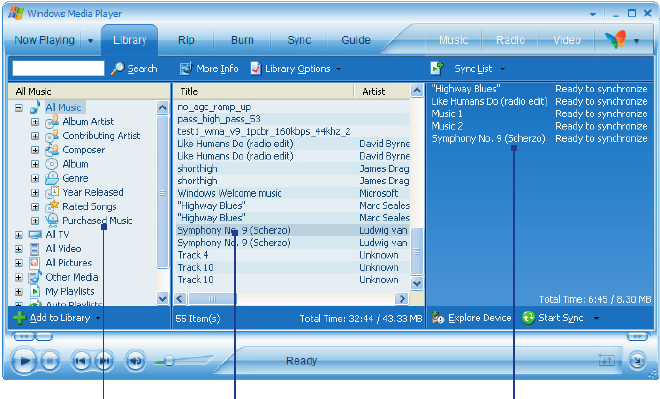
Experiencing Multimedia 91
Copy files to your phone
Use the Sync feature in the desktop version of Windows Media Player to synchronize (copy) digital media files
from your PC to your phone. Using Sync ensures that protected files and album art (for skins) are copied to
your phone correctly.
To synchronize content to your phone automatically
1. On your PC, start Windows Media Player.
2. Insert a 32MB or larger storage card into your phone, and then connect your phone to your PC.
3. If you have not set up synchronization between your phone and PC, the Device Setup Wizard opens on
your PC.
4. In the wizard, click Automatic, select the Customize the playlists that will be synchronized check
box, and then select the playlists that you want to synchronize.
5. Click Finish.
6. The files begin synchronizing to your phone. The next time you connect your phone to your PC while
the desktop version of Windows Media Player is running, synchronization will start automatically.
To synchronize and copy content manually to your phone
1. If you have not set up synchronization between your phone and PC, follow steps 1 to 5 in
“To synchronize content to your phone automatically”, except that you should click Manual
synchronization.
2. To choose files to synchronize and copy to your phone, do the following:
• Click the Library tab.
• In the rightmost pane, click the drop-down list and select Sync List.
• In the Playlist which is the leftmost pane, select a desired playlist.
Playlist File List Sync List
• In the File List which is the middle pane, multi-select desired files then drag them to the Sync List.
• Click the Start Sync button found at the bottom of the Sync List.
92 Experiencing Multimedia
Notes
• Always use the desktop version of Windows Media Player 10 to synchronize (copy) files to your phone. For
example, do not use Windows Explorer to drag and drop files from your computer to your phone.
• Always synchronize files to a storage card that is inserted into your phone. Do not synchronize to a storage card
that is inserted into a storage card reader.
• Audio files copy faster if the desktop Player is configured to automatically set the quality level for audio files
copied to your phone. For more information, see the desktop Player Help.
• The desktop version of Windows Media Player 10 is only available for computers running Windows XP. If you are
not running Windows XP on your PC, use the Copy to CD or Device feature of Windows Media Player 9 Series to
copy your audio files and video files to your phone.
• The desktop version of Windows Media Player 9 Series is not as full-featured as the desktop version of Windows
Media Player 10. For example, the desktop version of Windows Media Player 9 Series does not support automatic
synchronization, synchronization of playlists, synchronization of album art, or synchronization of TV shows
recorded by computers running Windows XP Media Center Edition.
• For more information about the Copy to CD or Device feature, start the desktop version of Windows Media Player
9 Series, and then press F1.
Play media
To play media on your phone
Use the library to find and play songs, videos, and playlists that are stored on your phone or removable
storage card.
1. If you are not on the Library screen, click Menu > Library.
2. If necessary, on the Library screen, click Menu > Library, and then select the library that you want to
use (for example, Storage Card).
3. In most cases, Windows Media Player Mobile automatically updates the library. However, you can
manually update the library to ensure that it contains new files that you recently copied to your phone
or storage card. Click Menu > Update Library to manually update the library list.
4. Select a category (for example, My Music or My Playlists), select the item that you want to play (such
as a song, album, or artist name), and then click Play.
Note To play a file that is stored on your phone but is not in a library, on the Library screen, click Menu > Open File.
Select the item that you want to play (such as a file or a folder), and click Play.
To play media on a network
Use the Open URL command to play a song or video that is stored on the Internet or on a network server.
1. If you are not on the Library screen, click Menu > Library.
2. Click Menu > Open URL.
3. Do one of the following:
• In URL, enter a network address.
• In History, select a URL that you have previously used.
Note To play media on a network, your phone must be connected to a network.
Change Player appearance
You can change the appearance of the Playback screen by choosing a new skin.
1. If you are not on the Playback screen, press BACK to display the Playback screen.
2. Click Menu > Options > Skins.
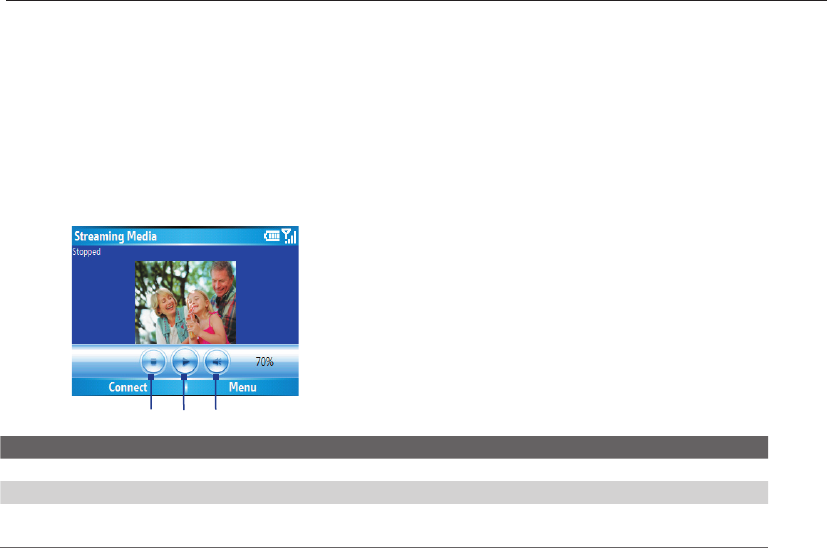
Experiencing Multimedia 93
3. To select a skin, press NAVIGATION left or right until you find the skin that you want to use.
4. Click Done.
Notes
• To download new skins, see the WMplugins.com site (http://www.wmplugins.com).
• After downloading a skin to your computer and unzipping it if necessary, use ActiveSync to copy the .skn and
.bmp files to your phone (such as to the location, Smartphone\Program Files\Windows Media Player, on the
phone). To ensure that skins appear on the Skins tab, do not store skin files in the Windows folder on your phone.
Troubleshooting
If you encounter any difficulty while using Windows Media Player Mobile, a number of resources are available
on the Web to help you troubleshoot the issue, including a list of frequently asked questions (FAQ).
For more information, see the Troubleshooting Windows Media Player Mobile page at the Microsoft Web site
(http://www.microsoft.com/windows/windowsmedia/player/windowsmobile/troubleshooting.aspx).
7.4 Using Streaming Media
The Streaming Media program allows you to stream live broadcasts or on-demand media content from the
Web. You do not have to wait until the entire media content is completely downloaded before watching the
video or hearing the sound. The media is sent in a continuous stream to your phone and is played as it arrives,
along with the audio.
2 3
1
Button control Function
1. Play/Pause Press the ENTER button to play/pause playback.
2. Stop Press NAVIGATION left to stop playback.
3. Volume Press NAVIGATION up/down to increase/decrease volume.
Press NAVIGATION right to mute/unmute the audio.
The Streaming Media program allows you to play 3GP and MPEG-4 files. It also supports playback of SDP
(Session Description Protocol) files. An SDP file is a text file that contains the format, broadcast times, media
content, and other information about a live broadcast, or it may contain a playlist and links to prerecorded
media files if you are viewing on-demand streaming media.
To access streaming content via Internet Explorer
In Internet Explorer, you can open a Web page containing http links to streaming media content and play the
content in the Streaming Media program.
1. Click Start > Internet Explorer.
2. Click Menu > Address Bar. In the address bar, enter the URL address of the Web page that contains the
http link to the desired *.3gp, *.mp4, or *.sdp file.
3. On the Web page, select the RTSP link and press the ENTER button.
4. Streaming Media then automatically opens and starts playing the file. During playback, use the button
controls to play/pause the video and adjust the sound volume.
Tip Click Menu > Zoom > Zoom In to zoom in on the video.
94 Experiencing Multimedia
To stream media files directly on the Streaming Media Player
Streaming Media only supports RTSP links when you stream *.3gp and *.mp4 files directly on the program.
Note Before you launch the Streaming Media program, make sure that you are connected to the Internet.
1. Click Start > Streaming Media.
2. From the program, click Connect.
3. Enter the URL for the Web site (rtsp://) and the file name.
4. Click Go.
5. Streaming Media then starts playing the file. During playback, use the button controls to play/pause
and adjust the sound volume.
To view streaming video file information
You can view the properties and general information of a streaming video clip, such as file format, audio
codec, dimension, frames, and duration of the video.
• Click Menu > Properties from the program.
To configure streaming video connection settings
Click Menu > Options to configure the following settings:
• Connect via. Choose whether you want to connect to the Internet or corporate network (intranet) to
locate a streaming video clip.
• UDP port range. Specify a range of port numbers to use for streaming.
• Media buffer. Specify the memory space (in terms of duration) to allot for storing video and audio data
while streaming media.
7.5 Using MIDlet Manager
MIDlets are Java-based applications that can run on mobile devices. Your phone supports Java 2 Edition,
J2ME. The MIDlet Manager allows you to download Java-based applications, such as games and tools that are
specifically designed for mobile devices. The Java MIDlet Manager gives you the flexibility of installing and
managing additional J2ME applications from the Internet.
To install MIDlets from the Internet
1. On the Home screen, click Start > MIDlet Manager.
The Java Apps screen appears.
2. Click Menu > Install > Browse to open Internet Explorer Mobile.
3. Locate the MIDlet/MIDlet suite while connected to the Internet.
4. Select the MIDlet/MIDlet suite to download.
5. To start installing the MIDlet/MIDlet suite, click Yes.
6. Click Done to confirm the installation.
Notes
• You can cancel the installation at any time.
• Downloaded MIDlets will be automatically saved in the My Documents folder.
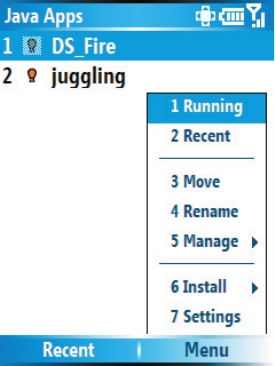
Experiencing Multimedia 95
To install MIDlets from a PC
You can install the MIDlets/MIDlet suites on your phone from a PC using the USB sync cable or Bluetooth.
MIDlets copied to your phone using Bluetooth or e-mail attachments are automatically saved in the My
Documents folder. However, you can copy the MIDlet file(s) from a PC to any of the following temporary
folders on your phone from where MIDlet Manager can install them.
• Device memory: ../Smartphone/My Documents/My MIDlets
• Storage card: ../Smartphone/Storage Card
Note If the My MIDlets folder does not exist in My Documents, you can create one with the same folder name. However,
a folder named Storage Card automatically appears after you insert a storage card into your phone.
To install MIDlets from a local folder
1. On the Home screen, click Start > MIDlet Manager.
The Java Apps screen appears.
2. Click Menu > Install > Local to install the MIDlets currently saved in the My MIDlets folder.
Click Recent to view the MIDlets or a MIDlet suite used recently on your phone.
3. Select the MIDlet/MIDlet suite from the list using the NAVIGATION CONTROL.
4. Click Menu > Install.
5. Click Yes to install.
6. Click Done to confirm the installation.
Note To remove the MIDlet files from the default folder, click Menu > Delete.
MIDlet Manager
To run MIDlets on your phone
1. On the Home screen, click Start > MIDlet Manager.
The Java Apps screen appears.
2. Select a MIDlet from the list using the NAVIGATION CONTROL.
3. Press ENTER to run the MIDlet.
To view the MIDlets currently running
• On the MIDlet Manager Java Apps screen, click Menu > Running.
Note To view the most recently used MIDlets, click Menu > Recent.
96 Experiencing Multimedia
To stop running a MIDlet
1. On the Home screen, click Start > MIDlet Manager.
The Java Apps screen appears.
2. Click Menu > Running.
3. Select a MIDlet on the Running MIDlets screen, and click Menu > Stop.
Note To stop all MIDlets currently running on your phone, click Menu > Stop All.
Manage MIDlets
You can organize the MIDlets into groups and define custom groups. You can also change the default display
settings for a MIDlet.
To customize the display settings
1. On the Home screen, click Start > MIDlet Manager.
The Java Apps screen appears.
2. Click Menu > Settings.
3. On the Settings screen, select Display Options using the NAVIGATION CONTROL.
4. Press ENTER.
5. In View Options, choose to display the MIDlets either in groups or all at once.
6. In Sort Options, choose to sort by Name or by Size.
7. Click Done.
To change the display name of a MIDlet
1. On the Home screen, click Start > MIDlet Manager.
The Java Apps screen appears.
2. Select a MIDlet using the NAVIGATION CONTROL.
3. Click Menu > Rename.
4. Enter a new name for the MIDlet.
5. Click Done.
Note You cannot change the name of a MIDlet suite.
To uninstall a MIDlet
Before you uninstall a MIDlet/MIDlet suite, make sure that it is not running.
1. On the Java Apps screen, select the MIDlet/MIDlet suite using the NAVIGATION CONTROL.
2. Click Menu > Manage > Uninstall.
3. Click OK to confirm.
Note You cannot uninstall a single MIDlet from a MIDlet suite; you must uninstall the complete MIDlet suite.
To check storage space
1. On the Home screen, click Start > MIDlet Manager.
2. Select a MIDlet using the NAVIGATION CONTROL.
3. On the Java Apps screen, click Menu > Settings.

Experiencing Multimedia 97
4. On the Settings screen, select System Info using the NAVIGATION CONTROL.
5. Press ENTER to see how much phone storage space is used by the MIDlet.
6. Click OK.
To select a network type
1. On the Java Apps screen, click Menu > Settings.
2. Select Choose Network Type using the NAVIGATION CONTROL.
3. Choose a network type from the list.
4. Click Select.
To configure MIDlet security
You can adjust security settings for each MIDlet/MIDlet suite.
1. On the Java Apps screen, select a MIDlet using the NAVIGATION CONTROL.
2. Click Menu > Manage > Security.
3. Configure the security options, such as Local Connectivity, App Auto Run, Messaging, and so on.
Please note that some features may not be available for all MIDlets/MIDlet suites. Following are the security
options that you can set for a running MIDlet/MIDlet suite.
Security Option Description
Net Access Determines whether a MIDlet/MIDlet suite can access the Internet.
Local Connectivity Enables a MIDlet/MIDlet suite to access services, such as Bluetooth.
App Auto Run Enables a MIDlet/MIDlet suite to run at specified times, or any time.
Messaging Determines whether a MIDlet/MIDlet suite can send and/or receive text (SMS)
messages.
Multimedia Recording Enables a MIDlet/MIDlet suite to record sounds and images.
Error messages
The following is a list of error messages that you may receive while managing and using MIDlets/MIDlet suites
on your phone.
Error Message Description
Either RAM shortage, or insufficient
space on the file system.
There is insufficient memory on your phone.
Network out. There is no network connection available.
The jar size does not match that
specified in the jad.
The installation information provided by the MIDlet manufacturer is
inaccurate.
The jar manifest does not match the
jad.
The installation information provided by the MIDlet manufacturer is
inaccurate.
Invalid Java application descriptor
(jad).
There is a problem with the installation file provided by the MIDlet
manufacturer.
Invalid Java archive (jar). There is a problem with the installation file provided by the MIDlet
manufacturer.
This Java application is not compatible
with this device.
One or more features required by this MIDlet is not available on your phone.
98 Experiencing Multimedia

Chapter 8
Using Other Applications
8.1 Using Doc Viewer
8.2 Using Speed Dial
8.3 Using Voice Speed Dial
100 Using Other Applications
8.1 Using Doc Viewer
Doc Viewer consists of four programs that let you view various types of documents, such as Word documents,
Powerpoint presentation files, Excel worksheets, and Acrobat PDF files. Doc Viewer consists of the following
programs:
• ClearVue Presentation (displays PowerPoint files)
• ClearVue Worksheet (displays Excel files)
• ClearVue Document (displays Word files)
• Adobe Reader LE (displays Acrobat PDF files)
To access Doc Viewer, click Start > Doc Viewer, then locate the program you want to open.
Note Not all fonts, colors, features, and versions of the desktop versions of PowerPoint, Word, Excel, and Acrobat are
supported, but these programs will show a close approximation.
ClearVue Presentation
ClearVue Presentation is a complete PowerPoint viewer solution with the ability to view native PowerPoint
presentations. With ClearVue Presentation, you will see the original presentation complete with animations
and transitions.
Note ClearVue Presentation only supports Powerpoint files created in Office 97 or later versions.
To open a presentation file
1. Click File > Open, and then locate the .ppt or .pps file.
2. Click Open.
To change the view
ClearVue Presentation lets you view your presentation file in 3 modes. Click View, and then select Normal,
Slide Sorter, or Notes.
• Normal. Displays a large single image of the current slide and below it, small thumbnail images of other
slides in the presentation.
• Slide Sorter. Slides will be displayed as small thumbnails.
• Notes. Lets you to view any slide notes that might have been stored in the original presentation.
To change the zoom ratio of the view mode
• Click View > Scale.
Note This only applies to Normal and Notes view modes.
To set up your presentation show
1. Click View > Set Up Show.
2. In Advance Slides, select how you want to advance to the next slide.
• Manually. Press NAVIGATION right to advance through the slides.
• Use timings. Uses the timing information stored in the PowerPoint file to determine when to display
the next slide.
• Automatically. Automatically advances to the next slide based on the time set in after __ secs.
Tip Click Loop continuously to loop the presentation. You need to manually stop the presentation. To learn how to
stop the presentation, see "To view your presentation."
Using Other Applications 101
3. Select the Orientation when viewing the presentation.
4. Click Black slide at end to add a blank slide after the last slide in the presentation.
To set up a custom show
1. Click View > Custom Show.
2. In Show List, select the slide you want to edit, and then click Menu. In the Menu options, you can
choose to either add, delete, hide, move up or move down the slide.
Tip Click Reset to revert the presentation back to its original state.
To view your presentation
• Click View > View Show.
Tip While viewing the presentation, press the # key to open a menu which allows you to go to the next slide or
previous slide of your presentation, go to a specific slide or end the presentation.
ClearVue Worksheet
ClearVue Worksheet gives you the ability to view native Excel worksheets. It also lets you view embedded
charts and chart sheets as well.
Notes
• ClearVue Worksheet only supports Excel files created in Office 97 or later versions.
• Excel macros that might be in the original file will not run when loaded.
• Three-dimensional charts will be mapped into a two-dimensional space.
• Worksheet does not display images selected as a background in an AutoShape.
• Worksheet cannot open files that have been password protected using the “Save Options” password setting in
Microsoft Excel.
To open a worksheet file
1. Click File > Open, and then locate the .xls file.
2. Click Open.
To change the zoom ratio
• Click View, and then select a magnification.
To view another sheet in your worksheet file
• Click View > Sheet, and then select the sheet you want to view.
ClearVue Document
ClearVue Document lets you view Word documents, complete with tables, images, columns, bulleted lists, and
more.
Note ClearVue Documemt only supports Word files created in Office 97 or later versions.
To open a document file
1. Click File > Open, and then locate the .doc or .rtf file.
2. Click Open.
After you open a file in ClearVue Document, it initially displays using the default Page Width setting. This
means that the page is sized to fit within the available area of your phone’s screen.

102 Using Other Applications
Click Zoom to change the magnification as desired, then scroll through and view the document using the
NAVIGATION CONTROL on your phone.
Adobe Reader LE
Adobe Reader LE allows you to open and view Portable Document Format (PDF) files. These files usually have
a *.pdf file extension.
Adobe Reader LE supports password-protected PDF files with up to 128-bit encryption. When you open a
password-protected PDF file, you will be prompted to enter the password before the file can be opened.
To open a PDF file on your phone
1. Click Start > Doc Viewer > Adobe Reader LE.
2. Click Open.
3. Browse to a folder and select the PDF file you want to view.
Note To open another PDF file, click Open > Menu > Browse For File. You can also open a PDF file from File Explorer by
clicking it.
To navigate through a PDF file
Do any of the following:
• Press NAVIGATION up, down, right, and left to move up or down a page.
You can also use the press or key on the QWERTY keyboard to scroll through the pages.
• Click Menu > Go To and select an option to go to a specific page in the PDF file.
To enlarge or reduce the display size
1. Open a PDF file you want to view.
2. Click Menu > Zoom.
3. Select In, Out, or To% to enlarge or reduce the display size. Otherwise, select Fit Screen or Fit Width.
To customize page view and orientation
1. Open a PDF file you want to view.
2. Click Menu> View.
3. Select an option to suit your view.
To find text in a PDF file
1. Open a PDF file you want to view.
2. Click Menu > Find > Text.
3. Enter the text to be searched.
4. Choose search parameters, such as Match case, Whole word, Backwards, and finally tap Find.
To go to a bookmark in a PDF file
This option is only available if the PDF file contains bookmarks.
1. Open a PDF file you want to view.
2. Click Menu > Bookmarks.
3. Use the NAVIGATION CONTROL to select the bookmark you want to go to and click Select.
Using Other Applications 103
8.2 Using Speed Dial
You can create speed dial entries for frequently-called numbers or frequently-accessed items so you can dial a
number or access an item by pressing a single key.
To create a speed dial entry for a contact
1. On the Home screen, click Start > Contacts.
2. Select a contact.
3. Press ENTER to view the contact details.
4. Select the desired phone number and click Menu > Add to Speed Dial.
5. Enter appropriate details in Name, Value, and Keyboard assignment .
6. Click Done. To quit at any time during this process, click Menu > Cancel.
Note Speed dial entries can be created only for numbers that are stored in Contacts.
To create a speed dial entry for an item
1. On the Home screen, click Start then choose (just highlight) the item you want.
2. Click Menu > Add Speed Dial.
3. Enter details in Name, Value, and Keyboard assignment.
4. Click Done. To quit at any time during this process, click Menu > Cancel.
Note The first speed dial location is generally reserved for your voice mail. Speed Dial uses the next available location
by default. If you want to place a number in a location that is already used, the new number replaces the existing
number.
To retrieve a voice mail message
• On the Home screen, press and hold 1 to access your voice mailbox, and follow the prompts to retrieve
your messages.
To make a call or launch a program using Speed Dial
• If you have assigned a speed dial (for example, the second location) to a contact or a program in Speed
Dial, you can simply press and hold the 2 key on the phone keypad to dial the contact’s number or open
the program.
To delete a speed dial entry
1. On the Home screen, click Start > Speed Dial.
2. Select the desired entry and click Menu > Delete.
104 Using Other Applications
8.3 Using Voice Speed Dial
You can record a voice tag for a phone number, e-mail address, or Web page address that is stored in Contacts.
When you speak out the voice tag using Voice Speed Dial, your phone automatically dials the associated
phone number, opens an e-mail message using the associated address, or goes to the associated Web page.
To create a voice tag for a phone number, e-mail address, or URL in Contacts
1. On the Home screen, click Start > Contacts.
2. Select the desired contact, and press ENTER to open the contact card.
3. Select the item to which you want to assign a voice tag.
4. Click Menu > Add Voice Tag.
5. After a “beep” sound, begin recording the voice tag (preferably one easy-to-recognize word).
6. When the voice tag is successfully trained, the phone will play back the voice tag. Click OK.
7. Enter appropriate details in Name, Value, and Keyboard assignment
8. Click Done to save the new voice tag.
To quit at any time during this process, click Menu > Cancel.
To create a voice tag for a program
To create a voice tag for a program, for example, Calendar, do the following:
1. On the Home screen, click Start > Calendar. (Do not press ENTER when Calendar is selected.)
2. Click Menu > Add Voice Tag.
3. After the message/beep, say “Calendar.”
4. When the voice tag is successfully trained, the phone will play back the voice tag. Click OK.
5. Enter appropriate details in Name, Value, and Keyboard assignment. Click Done to save the new voice
tag. To quit at any time during this process, click Menu > Cancel.
To make a call or launch a program using the voice tag
1. Click Start > Voice Speed Dial.
2. After a “beep” sound, say the recorded voice tag that you have assigned to the phone number you
want to call or the program you want to launch. The phone plays back the voice tag and then dials the
number or launches the associated program.
Note You can also drag and hold the Volume Adjustment Slider down to launch Voice Speed Dial and record voice tags
for numbers, e-mail addresses, URL in Contacts, and programs.
Tip If the phone cannot recognize your voice tag, please try again and speak clearly and reduce the surrounding noise.
To edit, delete, and play voice tags
1. On the Home screen, click Start > Speed Dial.
2. Select the desired voice tag from the list.
3. Do any of the following:
• To change the voice tag, click Menu > Edit, make changes, and click Done.
• To delete the voice tag, click Menu > Delete.
To play back an existing voice tag at any time, click Menu > Play Voice Tag.
Appendix
A.1 Regulatory Notices
A.2 PC Requirement to Run ActiveSync 4.x
A.3 Specifications
106 Appendix
A.1 Regulatory Notices
Regulatory Agency Identifications
For regulatory identification purposes, your product is assigned a model number of LIBR100.
To ensure continued reliable and safe operation of your device, use only the accessories listed below with your
LIBR100.
The Battery Pack has been assigned a model number of LIBR160.
This product is intended for use with a certified Class 2 Limited Power Source, rated 5 Volts DC, maximum 1
Amp power supply unit.
Federal Communications Commission Compliance
• FCC Part 15.21
Any changes or modifications not expressly approved by the party responsible for compliance could
void the user’s authority to operate the equipment.
• FCC ID: NM8LIBR100
• FCC Part 15.19
“This device complies with part 15 of the FCC Rules. Operation is subject to the following two
conditions: (1) This device may not cause harmful interference, and (2) this device must accept any
interference received, including interference that may cause undesired operation.”
• FCC Part 15.105 (b)
This equipment has been tested and found to comply with the limits for a Class B digital device,
pursuant to part 15 of the FCC Rules. These limits are designed to provide reasonable protection against
harmful interference in a residential installation. This equipment generates, uses and can radiate radio
frequency energy and, if not installed and used in accordance with the instructions, may cause harmful
interference to radio communications. However, there is no guarantee that interference will not occur
in a particular installation. If this equipment does cause harmful interference to radio or television
reception, which can be determined by turning the equipment off and on, the user is encouraged to try
to correct the interference by one or more of the following measures:
• Reorient or relocate the receiving antenna.
• Increase the separation between the equipment and receiver.
• Connect the equipment into an outlet on a circuit different from that to which the receiver is
connected.
• Consult the dealer or an experienced radio/TV technician for help.
• FCC Hearing-Aid Compatibility (HAC) Regulations for Wireless Devices
On July 10, 2003, the U.S. Federal Communications Commission (FCC) Report and Order in WT Docket
01-309 modified the exception of wireless phones under the Hearing Aid Compatibility Act of 1988
(HAC Act) to require digital wireless phones be compatible with hearing-aids. The intent of the HAC Act
is to ensure reasonable access to telecommunications services for persons with hearing disabilities.
While some wireless phones are used near some hearing devices (hearing aids and cochlear implants),
users may detect a buzzing, humming, or whining noise. Some hearing devices are more immune than
others to this interference noise, and phones also vary in the amount of interference they generate.
The wireless telephone industry has developed a rating system for wireless phones, to assist hearing
device users find phones that may be compatible with their hearing devices. Not all phones have been
rated. Phones that are rated have the rating on their box or a label located on the box.
The ratings are not guarantees. Results will vary depending on the user’s hearing device and hearing
loss. If your hearing device happens to be vulnerable to interference, you may not be able to use a
rated phone successfully. Trying out the phone with your hearing device is the best way to evaluate it
for your personal needs.
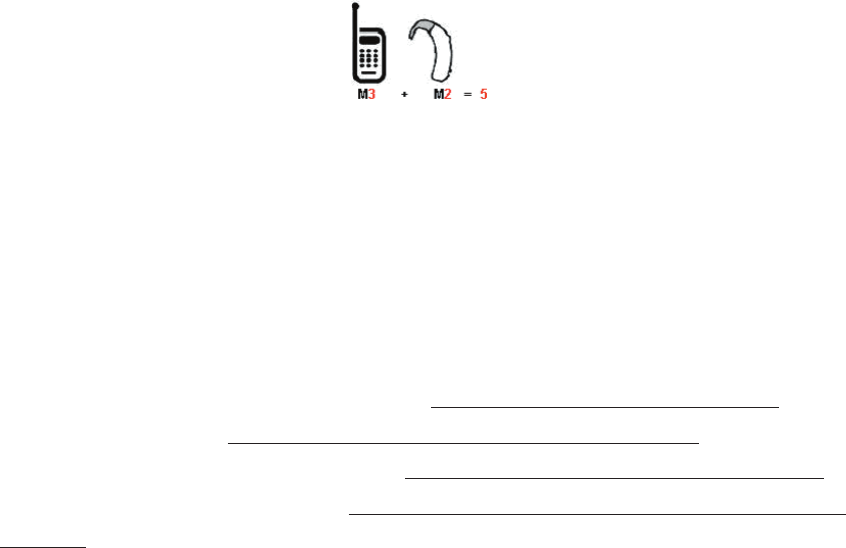
Appendix 107
M-Ratings: Phones rated M3 or M4 meet FCC requirements and are likely to generate less interference
to hearing devices than phones that are not labeled. M4 is the better/higher of the two ratings.
Hearing devices may also be rated. Your hearing device manufacturer or hearing health professional
may help you find this rating. Higher ratings mean that the hearing device is relatively immune to
interference noise. The hearing aid and wireless phone rating values are then added together. A sum of
5 is considered acceptable for normal use. A sum of 6 is considered for best use.
In the above example, if a hearing aid meets the M2 level rating and the wireless phone meets the M3
level rating, the sum of the two values equal M5. This should provide the hearing aid user with “normal
usage” while using their hearing aid with the particular wireless phone. “Normal usage” in this context is
defined as a signal quality that is acceptable for normal operation.
The M mark is intended to be synonymous with the U mark. The T mark is intended to be synonymous
with the UT mark. The M and T marks are recommended by the Alliance for Telecommunications
Industries Solutions (ATIS). The U and UT marks are referenced in Section 20.19 of the FCC Rules. The
HAC rating and measurement procedure are described in the American National Standards Institute
(ANSI) C63.19 standard.
For information about hearing aids and digital wireless phones
FCC Hearing Aid Compatibility and Volume Control: http://www.fcc.gov/cgb/dro/hearing.html
Gallaudet University, RERC: http://tap.gallaudet.edu/DigWireless.KS/DigWireless.htm
Self Help for Hard of Hearing People Inc. [SHHH]: www.hearingloss.org/hat/TipsWirelessPhones.htm
The Hearing Aid Compatibility FCC Order: http://hraunfoss.fcc.org/edocs_public/attachmatch/FCC-03-
168A1.pdf
Safety Precautions for RF Exposure
Use only original manufacturer-approved accessories, or accessories that do not contain any metal
Use of non-original manufacturer-approved accessories may violate your local RF exposure guidelines and
should be avoided.
Heed service markings
Except as explained elsewhere in the Operating or Service documentation, do not service any product
yourself. Service needed on components inside these compartments should be done by an authorized service
technician or provider.
Damage requiring service
Unplug the product from the electrical outlet and refer servicing to an authorized service technician or
provider under the following conditions:
• Liquid has been spilled or an object has fallen into the product.
• The product has been exposed to rain or water.
• The product has been dropped or damaged.
• There are noticeable signs of overheating.
• The product does not operate normally when you follow the operating instructions.

108 Appendix
SAR Information
• 1.490 W/kg @1g (Head)
• 1.380 W/kg @1g (Body)
THIS MODEL DEVICE MEETS THE GOVERNMENT’S REQUIREMENTS FOR EXPOSURE TO RADIO WAVES.
Your wireless mobile CDMA phone is a radio transmitter and receiver. It is designed and manufactured not to
exceed the emission limits for exposure to radio frequency (RF) energy set by the Federal Communications
Commission of the U.S. Government. These limits are part of comprehensive guidelines and establish
permitted levels of RF energy for the general population. The guidelines are based on the safety standards
previously set by both U.S. and international standards bodies:
• American National Standards Institute (ANSI) IEEE. C95.1-1992.
• National Council on Radiation Protection and Measurement (NCRP). Report 86. 1986.
• International Commission on Non-Ionizing Radiation Protection (ICNIRP) 1996.
• Ministry of Health (Canada), Safety Code 6. The standards include a substantial safety margin designed
to assure the safety of all persons, regardless of age and health.
The exposure standard for wireless mobile CDMA phone employs a unit of measurement known as the
Specific Absorption Rate, or SAR. The SAR limit set by the FCC is 1.6W/kg*.
The FCC has granted an Equipment Authorization for this model device with all reported SAR levels evaluated
as in compliance with the FCC RF exposure guidelines. SAR information on this model device is on file with
the FCC and can be found under the Display Grant section of http://www.fcc.gov/oet/fccid after searching on
FCC ID: NM8LIBR100. Additional information on Specific Absorption Rates (SAR) can be found on the Cellular
Telecommunications & Internet Association (CTIA) web-site as http://www.phonefacts.net.
* In the U.S. and Canada, the SAR limit for mobile CDMA phone used by the public is 1.6 Watts/kg (W/kg)
averaged over one gram of tissue. The standard incorporates a substantial margin of safety to give additional
protection for the public and to account for any variations in usage.
Normal condition only to ensure the radiative performance and safety of the interference. As with other
mobile radio transmitting equipment, users are advised that for satisfactory operation of the equipment and
for the safety of personnel, it is recommended that no part of the human body be allowed to come too close
to the antenna during operation of the equipment.
Telecommunications & Internet Association (TIA) safety information
Pacemakers
The Health Industry Manufacturers Association recommends that a minimum separation of six inches be
maintained between a handheld wireless phone and a pacemaker to avoid potential interference with the
pacemaker. These recommendations are consistent with the independent research by and recommendations
of Wireless Technology Research. Persons with pacemakers:
• Should ALWAYS keep the phone more than six inches from their pacemaker when the phone is turned
ON.
• Should not carry the phone in a breast pocket.
• Should use the ear opposite the pacemaker to minimize the potential for interference. If you have any
reason to suspect that interference is taking place, turn your phone OFF immediately.
Hearing Aids
Some digital wireless phones may interfere with some hearing aids. In the event of such interference, you may
want to consult your service provider, or call the customer service line to discuss alternatives.

Appendix 109
Other Medical Devices
If you use any other personal medical device, consult the manufacturer of your device to determine if they
are adequately shielded from external RF energy. Your physician may be able to assist you in obtaining this
information.
Turn your phone OFF in health care facilities when any regulations posted in these areas instruct you to do so.
Hospitals or health care facilities may be using equipment that could be sensitive to external RF energy.
Other tips and cautions
• Avoid using your phone near metal structures (for example, the steel frame of a building).
• Avoid using your phone near strong electromagnetic sources, such as microwave ovens, sound
speakers, TV and radio.
• Avoid using your phone after a dramatic change in temperature.
WEEE Notice
The Directive on Waste Electrical and Electronic Equipment (WEEE), which entered into force as European law
on 13th February 2003, resulted in a major change in the treatment of electrical equipment at end-of-life.
The purpose of this Directive is, as a first priority, the prevention of WEEE, and in addition, to promote the
reuse, recycling and other forms of recovery of such wastes so as to reduce disposal.
The WEEE logo on the product or on its box indicates that this product must not be disposed of or dumped
with your other household waste. You are liable to dispose of all your electronic or electrical waste equipment
by relocating over to the specified collection point for recycling of such hazardous waste. Isolated collection
and proper recovery of your electronic and electrical waste equipment at the time of disposal will allow
us to help conserving natural resources. Moreover, proper recycling of the electronic and electrical waste
equipment will ensure safety of human health and environment. For more information about electronic and
electrical waste equipment disposal, recovery, and collection points, please contact your local city centre,
household waste disposal service, shop from where you purchased the equipment, or manufacturer of the
equipment.
RoHS Compliance
This product is in compliance with Directive 2002/95/EC of the European Parliament and of the Council of
27 January 2003, on the restriction of the use of certain hazardous substances in electrical and electronic
equipment (RoHS) and its amendments.
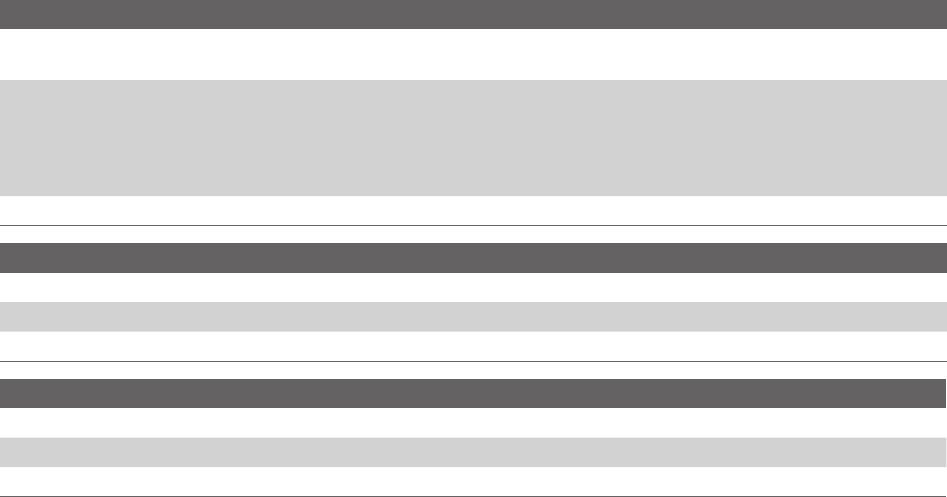
110 Appendix
A.2 PC Requirement to Run ActiveSync 4.x
To connect your device to the PC, you have to install Microsoft® ActiveSync® program on your PC. ActiveSync
4.x is included in the Getting Started Disc, which is compatible with the following operating systems and
applications:
• Microsoft® Windows® 2000 Service Pack 4
• Microsoft® Windows Server® 2003 Service Pack 1
• Microsoft® Windows Server® 2003 IA64 Edition Service Pack 1
• Microsoft® Windows Server® 2003 x64 Edition Service Pack 1
• Microsoft® Windows® XP Professional Service Packs 1 and 2
• Microsoft® Windows® XP Home Service Packs 1 and 2
• Microsoft® Windows® XP Tablet PC Edition 2005
• Microsoft® Windows® XP Media Center Edition 2005
• Microsoft® Windows® XP Professional x64 Edition
• Microsoft® Outlook® 98, Microsoft® Outlook® 2000 and Microsoft® Outlook® XP, and Microsoft® Outlook®
2003 messaging and collaboration clients
• Microsoft® Office 97, excluding Outlook
• Microsoft® Office 2000
• Microsoft® Office XP
• Microsoft® Office 2003
• Microsoft® Internet Explorer® 4.01 or later (required)
• Microsoft® Systems Management Server 2.0
A.3 Specifications
System information
Processor/
Chipset/Speed
QUALCOMMTM MSM 7500, 384 MHz
Memory • ROM-Nand Flash: 128 MB (Standard)
• RAM: 64 MB DDR
Figures are the total ROM and RAM memory available for use and storage. Since the memory is shared
by the Operating System, applications, and data, the actual available memory is less than what is written
.
Operating system Microsoft® Windows Mobile® Version 5.0 for Smartphone
Display
Type 2.4” QVGA Transmissive LCD with white LED backlight
Resolution 240 x 320 dots resolution at 65K Colors
Orientation Portrait and Landscape both
CDMA/EVDO Dual-band module
Functionality CDMA2000
Mode Dual band: 800 and 1900 MHz
Antenna Internal

Appendix 111
Camera module
Type 2.0 Megapixels CMOS (Landscape view)
Resolution • UXGA: 1600 x 1200
• SXGA: 1280 x 960
• VGA: 640 x 480
• QVGA: 320 x 240
• QQVGA: 160 x120
Connection
I/O port HTC ExtUSB™ : an 11-pin mini-USB and audio jack in one
(ExtUSB is a proprietary connection interface that is trademarked by HTC)
Bluetooth V 1.2 with A2DP support, Class 2 transmit power
Audio
Microphone/
speaker
Built-in microphone and speaker, Hands-free
Headphone AAC/AMR/WMA/WAV/MP3 codec
Physical
Dimension 100 mm(L) x 50 mm(W) x 18.2 mm(T)
Weight 120g with battery pack
Controls and lights
Buttons • CAMERA
• NAVIGATION CONTROL/ENTER
• POWER (on and off)/Quick List
• Left and Right SOFT KEYs
• HOME/Lock
• BACK
• TALK (start call/answer call)
• END
• Volume Adjustment Slider/Voice Speed Dial
Keyboard QWERTY type, 36 keys + 2 SOFT KEYs
LED • One multi-color (red/amber/green) LED for battery, connection, and network status.
• One blue-color LED for Bluetooth connection status.
Expansion slot
microSD slot microSD memory card
Power supply
Battery Li-Ion 1050 mAh removable, rechargeable battery
Talk time Up to 5 hours
Standby Up to 200 hours
AC Adapter • Voltage range/frequency: 100 ~ 240V AC, 50/60Hz
• DC output: 5V and 1A
112 Appendix
Index
114 Index
Symbols
1xEVDO 50
1xRTT 50
A
A2DP (Advanced Audio Distribution Profile) 57
Accessibility settings
- confirmation time out 42
- in-call alert volume 42
- multipress time out 42
- system font size 42
ActiveSync
- install and set up 30
- overview 16, 30
- synchronize 32
Add and remove programs 44
Adobe Reader LE
- overview 16
- use 102
Alarm 42
Alarm settings 41
Alerts 41
Answer/end call 26
Attachments 64
B
Backlight time out 43
Back up files 46
Battery
- battery information 21
- battery management 43
- check battery power 21
- low battery 21
Beam
- via Bluetooth 57
Bluetooth
- beaming 57
- Bluetooth modem 58
- hands-free headset 57
- modes 55
- overview 54
- partnerships 55
- stereo headset 57
- synchronize 35
- visible 55
C
Calculator 16
Calendar 16, 72
Call History 16
Camera
- camera button 80
- icons and indicators 81
- main menu 84
- overview 16
- zoom 84
Capture formats 81
Capture modes 80
ClearVue Document 16, 101
ClearVue Presentation 100
ClearVue Worksheet 16, 101
Clear Storage 16, 48
Close running programs 45
Comm Manager 16, 54
Compose
- e-mail/SMS message 63
- MMS message 68
- MMS message from template 69
Confirmation time out 42
Connect phone to Internet 50
Connect phone to private network 51
Contacts 16, 73
Contacts picture (capture mode) 80, 83
Cookies (Internet Explorer) 53
Copy
- files between phone and PC 46
- media files from PC to phone 91
- pictures and videos 85
- sound file to phone 41
Currency setting 40
Customize Home screen 40
Customize picture options 88
D
Date setting 40
Default view (Web page) 52
Delete pictures and videos 86
Desktop view (Web page) 52
Device lock 47
Dial-up connection 50
Digitally sign messages 36, 65
Digital Rights Management (DRM) 90
Digital signature
- sign, encrypt, decipher 65
- verify 66
Direct Push 34
Display time out 43
Doc Viewer 100
Download Agent 17
Download messages 64
E
E-mail
- attachments 64
- Outlook 62
- overview 62
- POP3/IMAP4 62
- security 36, 65
- send and receive 63
Edit picture 87
Emergency call 27
Encrypt messages 36, 65
Enter text and numbers 18
Error reporting 43
Event notification 41
Index 115
Exchange Server
- schedule synchronization 34
- synchronize 33
Exclude e-mail address when replying to all 64
F
Favorites (Internet Explorer) 52
File Explorer 17, 46
Find contacts online 75
Font size (display) 42
Full-screen mode (Internet Explorer) 52
G
Games 17
GIF animation 86
Global Address List (GAL) 75
H
Hide pictures on Web page 52
History (Internet Explorer) 53
Home screen
- change background 40, 87
- customize 40
- overview 15, 40
I
IMAP4 62
In-call alert volume 42
Insert pause in dialing sequence 27
Install Micro SD Card 15
Install MIDlets
- from Internet 94
- from PC 95
- locally 95
International call 27
Internet 50
Internet Explorer Mobile 17, 51
Internet Sharing 53
K
Keyboard
- lock 47
- sound 41
L
Landscape orientation 20
Language/locale setting 40
Launch camera from Pictures & Videos 86
LED indicator lights 14
Licensed and protected media 90
Lock
- keyboard 47
- phone 47
M
Make call
- from Call History 25
- from Contacts 25
- from Home Screen 24
- from Speed Dial 25
Media synchronization settings 35
Memory 45
Message folders 66
Messaging 17, 62
MIDlet Manager 17, 94
MMS
- access MMS 67
- add audio 70
- add photo/video 69
- add predefined text 70
- create and send 68
- menu options 70
- MMS settings 67
- view and reply 71
MMS video (capture mode) 80, 83
Modem
- Bluetooth modem 58
- USB modem 53
MSN Messenger 71
Multipress mode 18
Mute call 26
N
NAVIGATION CONTROL 13
Number format 40
Numeric mode 19
O
One column view (Web page) 52
Open PDF file 102
Operating system version 43
Optimize power performance 21
Outlook e-mail 62
Owner information 42
P
Panorama (capture mode) 80
Parts and accessories 12
Pause in dialing sequence 27
PDF 102
Personal information 42
Phone program 23
Phone specification 43
Photo (capture mode) 80, 83
Pictures
- assign to contacts 76, 88
- hide or show on Web page 52
- set as Home screen background 87
Pictures & Videos 17, 85
Picture theme (capture mode) 80, 83
Play media 92
116 Index
Pocket MSN 17, 71
POP3 62
Power management 43
Profile 41
Programs
- ActiveSync 16, 30
- Adobe Reader LE 16
- Calculator 16
- Calendar 16, 72
- Call History 16
- Camera 16, 80
- ClearVue Document 16, 101
- ClearVue Presentation 100
- ClearVue Worksheet 16, 101
- Clear Storage 16, 48
- Comm Manager 16
- Contacts 16, 73
- Download Agent 17
- File Explorer 46
- Games 17
- Internet Explorer 17, 51
- Internet Sharing 53
- Messaging 17, 62
- MIDlet Manager 17, 94
- Phone 23
- Pictures & Videos 17, 85
- Pocket MSN 17, 71
- Speed Dial 17, 103
- Streaming Media 17
- Tasks 17, 76
- Task Manager 17, 45
- Video Recorder 17, 80
- Voice Notes 17, 77
- Voice Speed Dial 17
- Windows Media Player Mobile 17, 88
Q
Quick List 18
QWERTY keyboard 18, 20
R
Receive
- call 26
- e-mail/SMS message 63
- MMS message 71
Regional settings 40
Reply
- e-mail/SMS message 64
- MMS message 71
Reset phone 48
Restart phone 48
Review screen 82
Ring tone 24, 76, 78
Run MIDlets 95
S
Secure/Multipurpose Internet Mail Extension (S/MIME) 36
Security
- e-mail 36, 65
- Internet 53
Send
- contact’s details (vCard) 76
- email/SMS message 63
- instant message (MSN) 72
- MMS message 68
- pictures/videos via e-mail 87
Settings 17
Set up Home screen 40
SMS 62, 63
Sounds 41
Speakerphone 26
Speed Dial 17, 25, 103
Sports (capture mode) 80, 83
Start menu 17
Status indicators 16
Still image capture modes 83
Stop programs 45
Streaming Media 17, 93
Synchronize
- information types 33
- music, video, and pictures 35
- Outlook information with Exchange Server 33
- Outlook information with the computer 32
- schedule synchronization with Exchange Server 34
- start/stop synchronization 32
- storage card 36
- via Bluetooth 35
Sync Setup Wizard 30
System font size 42
T
T9 mode 19
Tasks 17, 76
Task Manager 17, 45
Temporary files (Internet Explorer) 53
Text messages (SMS) 62, 63
Text size (Web page) 52
Time setting 40
U
Unlock screen clock 41
V
vCard 76
Verify digital signature 66
Video (capture mode) 80, 83
Video Recorder 17, 80
View
- photo slide show 86
- pictures 86
Visible (Bluetooth) 55
Voice Notes 17, 77
Voice Speed Dial 17
Voice tag
- create voice tag for phone number, e-mail address, or URL in
Contacts 104
- create voice tag for program 104
- edit, delete, and play voice tags 104
Index 117
W
Web browser 51
Web page display options 52
Windows Media Player
- file formats 88
- menus 89
- overview 17
- synchronize 35
- troubleshooting 93
Windows Mobile software version 43
Z
Zoom 83
118 Index